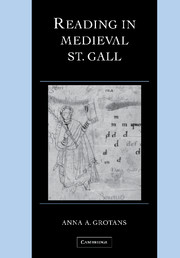Book contents
- Frontmatter
- Dedication
- Contents
- List of plates
- Acknowledgments
- List of abbreviations
- Manuscript punctuation and other symbols
- Introduction
- 1 Medieval reading
- 2 Education at ST. Gall
- 3 Language use and choice
- 4 The ST. Gall Tractate
- 5 Discretio in the classroom
- 6 Accentus
- 7 Spelling for reading
- Bibliography
- Index of manuscripts
- General index
1 - Medieval reading
Published online by Cambridge University Press: 13 May 2010
- Frontmatter
- Dedication
- Contents
- List of plates
- Acknowledgments
- List of abbreviations
- Manuscript punctuation and other symbols
- Introduction
- 1 Medieval reading
- 2 Education at ST. Gall
- 3 Language use and choice
- 4 The ST. Gall Tractate
- 5 Discretio in the classroom
- 6 Accentus
- 7 Spelling for reading
- Bibliography
- Index of manuscripts
- General index
Summary
Literacy and Orality
The old understanding of the relationship between literacy and orality in the early Germanic Middle Ages could be summed up as follows. Beginning in the first centuries AD, literacy slowly spread into the hitherto preliterate regions of northern Europe. Germanic cultures first came into contact with literacy through the Romans and their language, Latin. With the fall of the Roman Empire and the rise of Christianity, custody over literacy was secured by the Catholic Church, and Latin soon became the vehicle of the only established literary culture in the West. In Charlemagne's Empire, the lingua franca was the lingua latina. The caretakers of literary culture were monks and clerics, many of whom were also politically active at the royal courts. They were entrusted with the care and propagation of the written word, primarily of God but also of classical authors, which provided an educational framework and normative model for written Latin that was soon to be adapted by Church and government for their own purposes. Combined, these two Latin “scriptures” – the sacred and the profane – formed the canon upon which learning was based for many years to come. The vernacular languages were at first excluded from the sphere of literacy, but were cultivated by those lay people who continued to practise their own oral traditions.
- Type
- Chapter
- Information
- Reading in Medieval St. Gall , pp. 15 - 48Publisher: Cambridge University PressPrint publication year: 2006
- 1
- Cited by



